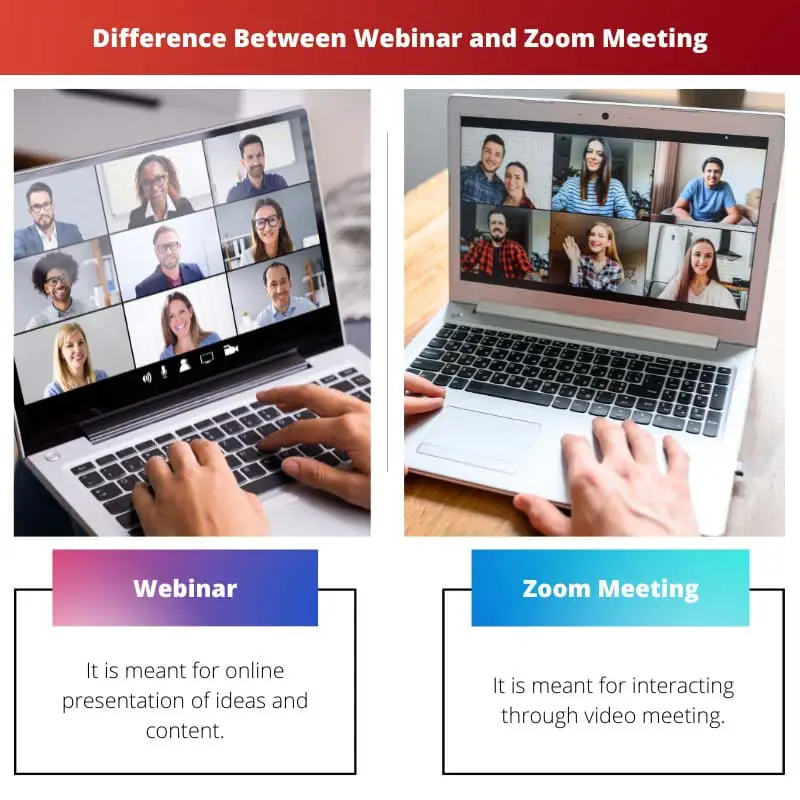Remote and hybrid working style is rapidly gaining popularity in recent times. Video-first collaboration solutions are emerging as an accessible solution for online conferencing.
But they are available in a huge variety and it is difficult to choose from them. Webinar and Zoom Meeting are two such online conferencing mediums, which are quite similar.
It is essential to differentiate between them for using them properly.
Key Takeaways
- Webinars are online events with a speaker presenting to a large audience, while Zoom meetings involve real-time video conferencing between participants.
- Webinars allow limited interaction between the presenter and the audience, while Zoom meetings enable more collaboration and discussion.
- Webinars can accommodate thousands of attendees, while Zoom meetings have fewer participants.
Webinar vs Zoom Meeting
The difference between Webinar and Zoom Meeting is that Webinars cater to large audiences and are used for presenting, while Zoom Meetings are designed for interaction between comparatively smaller groups.

A webinar is a short form for web- based seminar. It is similar to a virtual event. It provides the opportunity for presenting ideas and content to a wide audience.
The hosts of the webinar control what the audience is allowed to do. Hence the hosts decide whether the attendees can activate their audio and video, can chat or share files, etc.
Zoom Meeting is a cloud-based video conferencing tool. It is like a video meeting.
It facilitates interactive sessions and participation from the attendees. All the attendees can share their audio and video, chat and even share files at their own will, without seeking permission from the host.
Comparison Table
| Parameters of Comparison | Webinar | Zoom Meeting |
|---|---|---|
| Description | It stands for web- based seminar. | It is a cloud based video conferencing tool. |
| Basic Purpose | It is meant for online presentation of ideas and content. | It is meant for interacting through video meeting. |
| Best Uses | It is best for big events and public broadcasts, having 50+ attendees. E.g. Quarterly Updates, Town Halls and Educational Lectures. | It is best for interactive sessions between small to large groups, i.e. 2+ participants. E.g. Customer- facing meetings, Training sessions and Sales meetings. |
| Typically Used By | They are used by event hosts, heads of institutions or organizations and executive officers. | They are used by general employees, training groups and for online classes. |
| Participant Roles | Participants in a Webinar can take the role of a Host, Co- Host, Panelist or an Attendee. | Participants in a Zoom Meeting take the role of a Host, Co- Host or a Participant. |
| Content Sharing | Hosts, Co- Hosts and Panelists can share content. Attendees can do so only with their permission. | All participants can share content. |
| Audio and Video | Hosts, Co- Hosts and Panelists can share their audio and video. Attendees can do so only with their permission. | All participants can share their audio and video. |
| Chat and Q&A | Hosts, Co- Hosts, Panelists and Attendees can chat publicly only. Hosts can also disable chatting for attendees. However, they can use Q&A. | All the participants can chat privately and publicly. Hosts can disable the chats. However, they cannot use Q&A. |
What is Webinar?
‘Webinar’ is made up of two words: web and seminar. It is a type of online conference and refers to a seminar that is transmitted over the web.
It is thus a virtual seminar, which can be used for presenting ideas and content to a large audience.
Webinars, like seminars, are less interactive. Mostly the host, co-hosts, and panelists present content and ideas in front of the audience.
They are equipped with tools like screen sharing, whiteboard, annotations, etc.
The hosts of a Webinar are in control of the audience’s activities. The attendees cannot chat or share their audio, video, or any files without the host’s permission.
However, they can interact with the panelists through features like Q&A, Polls and Surveys, etc.
Webinars are ideal for use when we need to present information to a large audience, for instance during town halls, educational lectures, or quarterly updates. They are also used by heads of institutions or by executive officers when they need to disseminate information to the organization.

What is Zoom Meeting?
Zoom Meeting is a cloud-based online video conferencing tool. It allows users to hold interactive and collaborative meeting sessions through the internet.
It is a virtual meeting, where the participants can interact freely.
The participants in a Zoom Meeting communicate using the chatbox, by sharing their audio, video, and screens. They can also use the whiteboard, annotations, etc. for enriching their discussions.
The host of a Zoom Meeting can also create breakout rooms, where smaller groups out of the total participants can interact separately.
Zoom Meetings are best used for holding online discussions and interactive sessions, e.g. for customer-facing meetings, online classes, training sessions, and team discussions. They are used by employees and teachers.

Main Differences Between Webinar and Zoom Meeting
- Webinars are web-based seminars, meant for presenting information like in seminars, whereas Zoom Meeting is an online video conferencing tool, meant for interactive sessions like in meetings.
- Webinars are best used for large events and public broadcasts where information has to be disseminated to a large audience, while Zoom Meetings are best used for interactive sessions between smaller groups of people.
- Webinars are used by event heads or executive officers when they wish to gather a large audience, whereas Zoom Meetings are used by general employees or teachers for holding discussions or taking classes.
- The participants in a Webinar can be hosts, co-hosts, panelists, or attendees. However, participants in a Zoom Meeting can be hosts, co-hosts, or participants.
- In a Webinar, the hosts, co-hosts, and panelists can chat, share content, audio, and video at their will, while the attendees have to take permission from the host for the same. In a Zoom Meeting, on the other hand, all the participants can chat, share content, audio, and video at their will.



